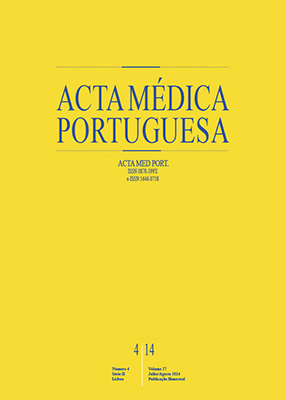Hipotiroidismo Secundário à Irradiação Cervical: Avaliação Sistemática da Função Tiroideia no Seguimento
DOI:
https://doi.org/10.20344/amp.5109Resumo
Introdução: A disfunção tiroideia constitui uma consequência, por vezes subestimada, da exposição à radiação. O mecanismo subjacente não está claramente esclarecido, mas terá uma origem multifatorial. Os fatores de risco específicos para o desenvolvimento de hipotiroidismo secundário à radioterapia permanecem indeterminados. A irradiação direta da glândula tiroideia pode resultar, com maior frequência, em hipotiroidismo. Este é uma condição irreversível, requerendo monitorização e tratamento permanente.
Objetivos: Avaliar a incidência de hipotiroidismo nos doentes portadores de neoplasias da cabeça e pescoço submetidos a irradiação cervical, a título intensivo ou adjuvante, bem como determinar se é justificável a integração no protocolo de seguimento Institucional, de parâmetros laboratoriais (TSH, T3 Livre e T4 Livre) para avaliação da função tiroideia neste grupo de doentes e qual a sua periodicidade.
Material e Métodos: Este é um estudo observacional, descritivo, retrospetivo, que engloba um grupo de 376 doentes portadores de neoplasias da cabeça e pescoço, submetidos a tratamento de radioterapia, a título adjuvante ou intensivo, entre os anos de 2007 e 2012, no Instituto Português de Oncologia de Coimbra Francisco Gentil E.P.E. Cumpriram todos os critérios de inclusão 145 doentes. Foram utilizadas escalas de avaliação padronizadas para a definição de hipotiroidismo – LENT-SOMA scales (Late Effects Normal Tissues Subjective Objective Management Analysis). Foi considerada como complicação o hipotiroidismo Grau 1 ou superior.
Resultados: Procedeu-se à análise de um grupo de 145 doentes. A localização tumoral mais frequente foi a Laringe (26,9%). Trinta e dois doentes efetuaram radioterapia adjuvante e 113 efetuaram esquemas intensivos. A técnica de radioterapia mais utilizada foi a intensidade modulada (IMRT), efetuada em 86,2% doentes. A taxa de incidência global de hipotiroidismo aos 12 meses foi de 18,6%. Em 51,9% dos doentes foi efetuado o diagnóstico de hipotiroidismo entre os 9 e os 12 meses após o tratamento de radioterapia.
Discussão: Da análise da literatura publicada, o hipotiroidismo constitui a complicação tiroideia radioinduzida mais frequente e afeta uma grande percentagem de doentes submetidos a radioterapia cervical com intenção curativa. Foi demonstrado que o risco de hipotiroidismo aumenta com o tempo após a exposição, contudo a incidência mais elevada parece ser nos dois primeiros anos após o tratamento. Da nossa análise obtivemos, aos 12 meses uma taxa de incidência global de hipotiroidismo de 18,6%, (grau 1 de 16,55% e grau 2 de 2,1%).
Conclusão: Neste estudo foi encontrada uma incidência de hipotiroidismo correspondente aos valores mais baixos descritos em outros estudos publicados. O curto tempo de follow-up considerado nesta análise poderá justificar os resultados obtidos. Face aos resultados obtidos, e correlacionando-os com a literatura disponível, os autores consideram justificável e recomendável a inserção da avaliação sistemática da função tiroideia no protocolo de follow-up destes doentes.
Palavras-chave: Neoplasias da Cabeça e Pescoço; Radioterapia; Hipotiroidismo; Estudos de Seguimento.
Downloads
Downloads
Publicado
Como Citar
Edição
Secção
Licença
Todos os artigos publicados na AMP são de acesso aberto e cumprem os requisitos das agências de financiamento ou instituições académicas. Relativamente à utilização por terceiros a AMP rege-se pelos termos da licença Creative Commons ‘Atribuição – Uso Não-Comercial – (CC-BY-NC)’.
É da responsabilidade do autor obter permissão para reproduzir figuras, tabelas, etc., de outras publicações. Após a aceitação de um artigo, os autores serão convidados a preencher uma “Declaração de Responsabilidade Autoral e Partilha de Direitos de Autor “(http://www.actamedicaportuguesa.com/info/AMP-NormasPublicacao.pdf) e a “Declaração de Potenciais Conflitos de Interesse” (http://www.icmje.org/conflicts-of-interest) do ICMJE. Será enviado um e-mail ao autor correspondente, confirmando a receção do manuscrito.
Após a publicação, os autores ficam autorizados a disponibilizar os seus artigos em repositórios das suas instituições de origem, desde que mencionem sempre onde foram publicados e de acordo com a licença Creative Commons









